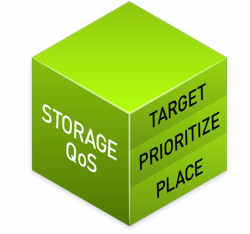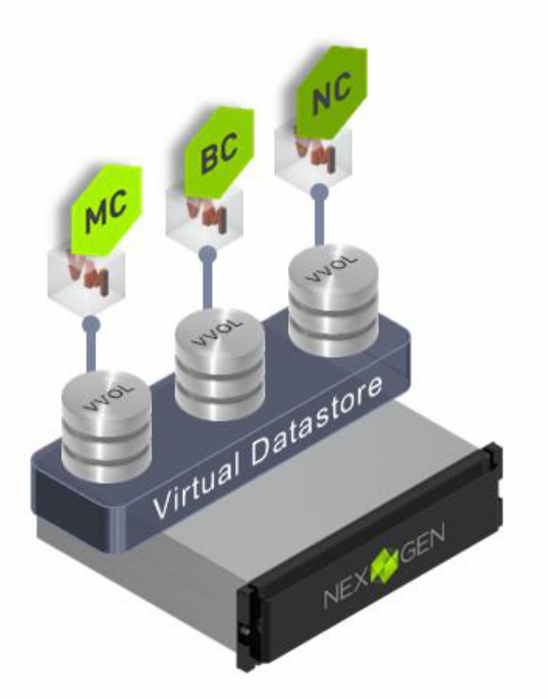NexGen Storage Assigned Patent
For QoS engine for flash systems
This is a Press Release edited by StorageNewsletter.com on November 20, 2015 at 2:44 pmNexGen Storage, Inc. announced that the company has been granted a patent by the U.S. Patent Office for its application, titled Primary Storage System With QoS, US Patent 9,176,708.
As customers deploy first generation all-flash arrays, many are surprised to encounter inconsistent performance caused by unexpected latency spikes due to the effects of complex deduplication algorithms, cache overflows, SAS controller bottlenecks, overworked CPUs and other system constraints. The patented dynamic QoS solution is a set of core architectural capabilities that make up company’s PCIe Flash Array data management software. Company’s customers use Storage QoS to easily set performance targets via simple policies, automatically deliver required performance across multiple applications simultaneously, prioritize workloads and place data in the appropriate cache or tier to ensure mission-critical applications get guaranteed performance. Company’s patented QoS engine simplifies performance management and enables customers to confidently consolidate more business-critical applications on their all-flash arrays. Customers get the performance they expect from an all-flash array and thus avoid end user complaints and the impact on business productivity caused by unexpected latency spikes.
“As the types of non-volatile media proliferate, some with better performance, some with better endurance, and others with lower cost and higher capacity points, it becomes clear that there will never be one single uber-media that’s the best at everything,” said Kelly Long, CTO and founder, NexGen Storage. “The only way to provide customers with a simple way to combine the best traits of these various types of media is with dynamic Storage QoS.“
Patented QoS allows customers to consolidate more workloads while guaranteeing consistent mission-critical application performance to get the most from their flash investment. Capabilities that set NexGen QoS apart include:
-
Targets with automated throttling. QoS simplifies performance management by using a statistics database to monitor all workloads in real time, QoS automatically throttles lower priority workloads as needed and relieves customers from the burden of the guesswork associated with manual minimum, maximum and burst settings. Company’s patented approach simplifies management versus traditional QoS offerings that force users to predict which neighbor is going to be noisy or wait until a neighbor becomes noisy, then reactively throttling it by changing minimum, maximum and burst settings. The latter approach requires users to predict future workloads and guess how much to throttle, which is nearly impossible to do.
-
Priorities and ability to over-provision system performance. Just like thin provisioning for capacity, the ability to over-provision performance is required for maximum utilization of resources. Company’s dynamic QoS allows users to prioritize between the various performance targets during times of system resource contention so that the storage system makes the right trade-offs to ensure mission-critical applications get consistent performance. This approach differs from other QoS offerings that are limited to manual minimum, maximum and burst settings that cannot determine which workload should take priority and thus cannot simultaneously allow overprovisioning and guarantee mission-critical application SLAs. The ability to overprovision resources is especially critical to Service Providers who need to achieve maximum resource utilization while meeting SLAs.
-
Optimal data placement. With the proliferation of new types of non-volatile media, including several different types of flash, the only way to ensure that organizations achieve the most affordable all-flash system while avoiding latency spikes and contention is through the use of multi-tier flash arrays managed with a dynamic QoS engine. QoS prioritizes data placement in real-time to ensure that policies are met and end-user expectations are exceeded. NexGen’s approach differs from first generation all-flash arrays that were designed for a single type of flash that treats all data equally and doesn’t protect mission-critical applications from unexpected latency spikes.
-
vSphere Virtual Volume (VVol) integration. QoS is especially important for customers considering using vSphere 6 with Virtual Volumes (VVols). In these environments, automated, dynamic policy setting is essential to scale since VVols can increase the number of objects in a storage system by up to 30 times. Manually defining and entering minimum, maximum and burst settings for each object is burdensome and complex. QoS policies are integrated with VMware VVols to simplify VM-level performance management and make changing performance policies as simple as changing a selection on the drop down menu.
QoS capabilities are key to enabling the next generation of all-flash arrays and are a critical capability as more application workloads are consolidated onto all-flash arrays as the financial benefits of all-flash datacenters are understood. QoS engine is hardware agnostic or what the industry often refers to as ‘software defined.’ By replacing the RAID/disk controller adapter, which is used still by every first generation all-flash array vendor, QoS capabilities dynamically tier data across an unlimited number of PCIe-connected devices to deliver consistent, predictable performance in multi-tenant or multi-application environments. Offerings that rely on SAS fan-out back ends and centralized disk hardware/controller adapters limit QoS abilities to prioritize workloads due to the bottleneck/choke point, and inevitably cause unexpected latency spikes. QoS engine moves data directly from the network to multiple types of memory and across numerous paths in parallel to eliminate contention and latency spikes associated with hardware/controller adapters.














 Subscribe to our free daily newsletter
Subscribe to our free daily newsletter
